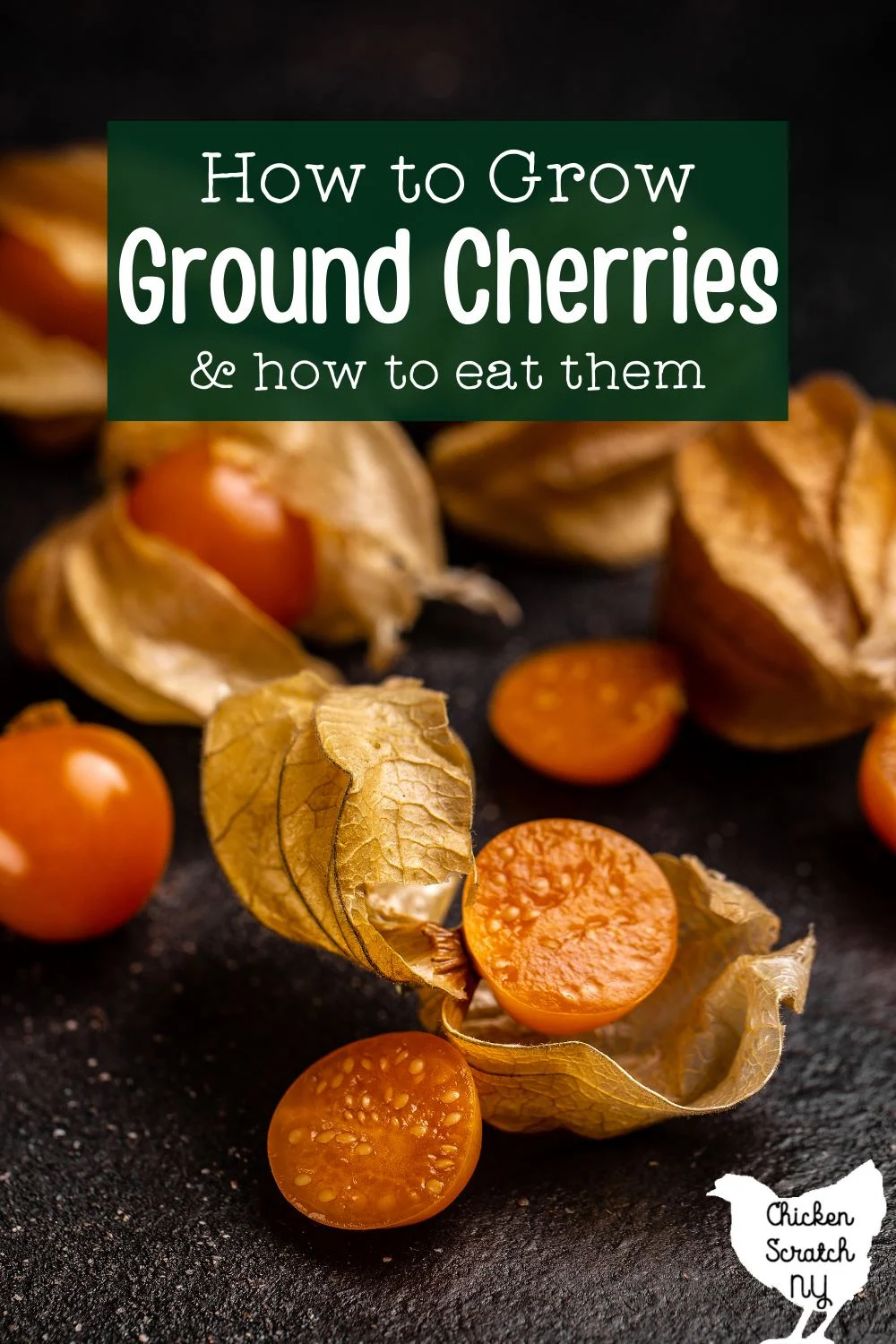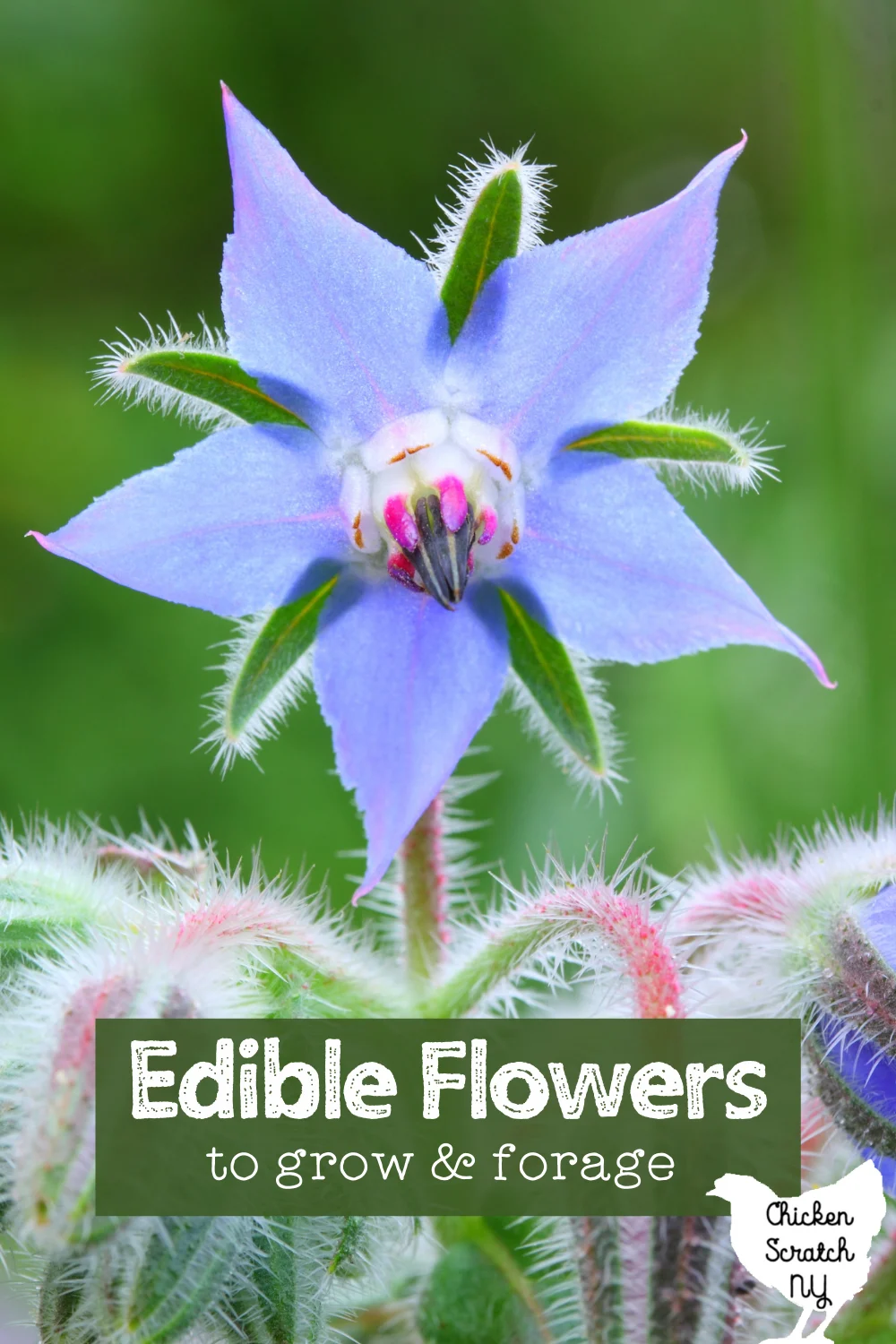Ground Cherries are a unique and delicious addition to your vegetable garden. The bushy annual plants are easy to grow and once you’ve tasted one you’ll never want to go without them!

Every year I try to grow something new and in 2017 I picked Ground Cherries also known as cape gooseberries or husk cherries. Just like I promised in the opening paragraph, I’ve never regretted it and I try to grow a few every year.
What are Ground Cherries?
Ground cherries are an annual fruiting plant in the Solanaceae family (eggplants, tomatoes, peppers & potatoes) and more specifically the Physalis genus which also includes tomatillos. If you’ve ever seen a tomatillo and its papery husk that probably makes a lot of sense to you.
Another close relative in the Physalis genus is Chinese Lanterns, a decorative plant grown for their lovely red lanterns. However Chinese Lanterns are toxic and should not be eaten!
Growing Ground Cherries
Hush Cherries are a warm-season crop and should be started indoors about the same time you’d start your tomatoes, about 6-8 weeks before the last frost. Or, like me, when you find the seed you put it in the drawer so you wouldn’t lose it.
They require a long growing season so if you want fruit you’ll need to give the plants a head start or they’ll be killed by frost before you get your berries. Unripe ground cherries are an emetic and can make you sick so you really want to let them ripen!
I’ve never seen started ground cherry plants in a greenhouse (and visiting small, local greenhouses is just about the only reason I willingly leave the house!) so if you want to grow this sweet fruit you’ll need to start them yourself.
Ground cherries germinate best at 75-90 degrees so you’ll want to put them on the heat mat to get started, preferably under a humidity dome. You can start them in a standard 1020 seed tray and transplant them to larger containers as they grow.
On a heat mat and kept sufficiently moist you should see seedlings pop their heads up between 7 and 10 days but it might take up to 14 days if you’re on the cooler side.
By the time the seedlings emerge the trays should be moved under a grow light. You never want your seedlings to get leggy and weak so always keep the light as close as possible.

Ground cherries should be moved out to the garden after frost, about 2 weeks after you transplant your tomatoes. Before you move them outside you need to harden them off or acclimate them to the cruel outdoors.
I move mine out to the shaded deck where they’re protected from the chickens during the afternoon for a few days to get used to the outdoors. Try to transplant on an overcast day, even better if it’s going to rain soon.
The plants grow pretty similarly to determinate tomatoes. Again, they’re relates so it’s not that shocking.
For the smaller varieties (Aunt Molly’s and other Physalis pruinosa) types aim for 2 foot spacing, you can even bump that up to 3 feet if you have the space and plan to let the plants sprawl instead of supporting them.
Larger plants should be kept about 3 feet apart. Physalis peruviana can get 3-4 feet wide and tall so they’ll do better with more room to stretch out.
Read more about Tomato Varieties
You can use tomato cages to support the plants and help keep them contained. Ground cherries themselves are very light and don’t need something overly strong to support them.
You can plant them deeply, like tomatoes they will send out roots along the length of their stem. I remove at least the lowest set of true leaves (assuming my plants are big enough to have more than one set) and then plant them in a trench.
It seems counterintuitive but I promise more roots will give you stronger plants in the end! There will likely be a short period of time where it looks like nothing is happening with your plants, but it its, it’s just all under ground.
Use mulch to keep the soil moist and make harvesting easier (we’ll get back to that in a second!).
Ground Cherry Varieties
Unlike tomatoes and peppers, there aren’t a ton of options when it comes to growing your own ground cherries. This year I’m growing two different varieties, I picked up seeds for both from Fedco Seeds.

First up is Aunt Molly’s Husk Cherry which is a variety of Physalis pruinosa. I think this is the most common variety of groundcherry. The packet lists 72 days to harvest after transplanting so I’m hoping for a lot of berries come August.
The second is Ambrosia which is a variety of Physalis peruviana or Cape Gooseberry. They have a longer number of days to harvest, 115 to be exact, pushing my snack time back to mid-September.
We usually have hard frosts by the end of the month so I’m less optimistic about these guys but I’m curious to see how different the two are in terms of flavor, plant health, and yield.
Despite the name, they aren’t related at all to actual gooseberries. Those are in the Ribes genus along with red, black and white currants.
Picking Ground Cherries
One of the trickiest parts of this plant is knowing when to harvest. After all, that husk hides the berry color and if you pick them too soon they’ll make you throw up.
A mature ground cherry plant can have 300+ flowers on it at once. They ripen individually and you’ll have ripe fruit, flowers and buds on the same plant all at the same time.
The key to a tasty harvest is that ripe ground cherries will fall right off the plant. That’s where a good mulch makes life easy.
The papery husks on the fruit are a light tan so using dark mulch will let the fruits stand out for easy picking. I wouldn’t use straw, that’s almost the same exact color as the husks!
For an easy harvest you can lay blankets or towels around the plants and give them a gentle shake. The ripe fruits should fall to the ground where you can eaisly scoop them up.
This is also my mulberry harvest method, but that’s a lot messier and will dye your sheets blue-purple.
What Do You Do with Ground Cherries?
You started the plants, carefully acclimated them to the outdoors, transplanted, watered, and mulched them. After about 70 days (depending on variety) the fruit will begin to trickle in.
If you plan to make something with your ground cherries make sure you put in a few plants. This year I’m planting 12, I’m hoping that leaves enough for fresh eating and some jam or maybe a pie.
Knowing me I’ll cook them down with a little sugar and fold them into whipped cream like my Berry Trifles or Black Raspberry Fool.
Ground Cherries have a very unique flavor. Everyone I shared them with was very surprised by the tropical taste. Store them in their husks in a cool dry place and they’ll last up to 3 months.
Ground Cherry Recipes
I’ll admit that I ate 98% of my ground cherries fresh in the garden and the other 2% I forced upon my unsuspecting family and friends (there were no complaints and after 33 years on this earth they expect it from me!)
If you’re a better ground cherry farmer than me you can try your hand at any of these lovely recipes :
- Mini Ground Cherry Pies by Freshly Baked by Photo Kitchen
- Ground Cherry Crumb Pie by Linn Acres Farm
- Ground Cherry Clafoutis by Chez Us
- Ground Cherry Jalapeno Pepper Jelly by Picky to Plenty
- Ground Cherry Lemon Jelly by Common Sense Homestead
- Ground Cherry Jam from At the Immigrants Table
- Ground Cherry Salsa by The Dig In
- Tomato Ground Cherry Salsa with Cilantro & Lime by Seattle Local Food
- Cherry Tomato and Ground Cherry Salsa by A Farm Girl Dabbles
Don’t forget to PIN this to your Gardening Board!
Check out my Vegetable Gardening page for more information or start here:




Randi
Thursday 11th of August 2022
Any danger to chickens or goats that free-range?
Thanks!
Alecia
Monday 15th of August 2022
The only nontoxic part of the plants is the ripe fruit, I have a few chickens that insist on flying over the fence into my garden and they seem to ignore the ground cherries.
When given lots of options most animals will ignore toxic plants, I wouldn't fence them into an area with nothing but ground cherries but having a few plants shouldn't affect your chickens.
I have less experience with goats, I know they can be pretty self destructive but again, if they have other food available I can't see them eating enough to cause any issues.
Lori
Thursday 16th of June 2022
I grew these for the first-time last year, which was my first garden. I absolutely loved the ground cherries! Last night, I suddenly remembered that I FORGOT to plant ground cherries this year! How could I forget, my newfound love? I just ordered some seeds. I am going to just plant some seeds even though it is June 16th. Do you think they will fruit? I am in Missouri. I guess I will give it a try. I enjoyed your blog. Lori
Alecia
Thursday 16th of June 2022
You never know until you try! They're so delicious and grow like weeds, I was really excited to see them available at a small local greenhouse this year. Good luck!
Leanne ward
Tuesday 1st of March 2022
I have started to grownmy seedlings indoors and am very excited to see how the ground cherries do in my garden box this year. I tried them at the farmers market last year and loved them... what spacing should I be giving these little guys? Tomatoes I give a 1'x1' area.. is it the same for ground cherries? Thanks for your help.
Cred
Wednesday 6th of November 2019
Ground cherries are the easiest things I grow. I planted them once and have been enjoying them every year since, as they are prolific self seeders. They tend to germinate late and take some time to size up, which is helpful given I live in Ontario, Canada. I don't have to worry about hardening off or frost. They will pop up all over my 12x12 bed, so I let them spread in between and amongst my garlic. Because they take awhile to really size up, they don't compete with the garlic which is pulled at the end of July here. Then the ground cherries have the space to themselves and they will produce right up to the first frost in the fall. Thanks for the recipe ideas. We mostly eat them fresh but I get a tonne of them so I'm making jam this year. Have you ever tried Jerusalem artichokes?
Rick Fenneman
Tuesday 12th of February 2019
This really brings back memories for me. My grandmother always had these growing along side her gardening shed. She canned these with peaches in a kind of sugary light syrup. This was on the table for every meal. Miss that and miss her. She has been gone for over 40 years and I still have fond memories of her and those ground cherries. Really nice post on an unusual subject.
Alecia
Wednesday 13th of February 2019
Thank you! Your grandmother sounds like a wonderful woman. I lost my grandfather a few years ago and he was the one that taught me to grow things, he used to plant green bean teepees and let me help when the new chicks came in. I do those things now with my kids to keep the tradition and memories alive.